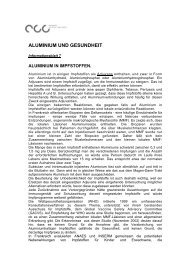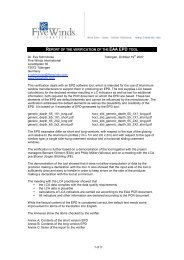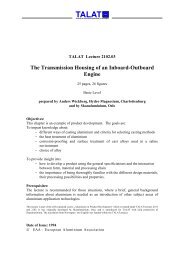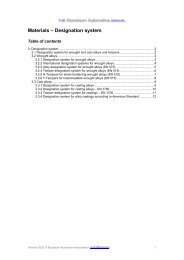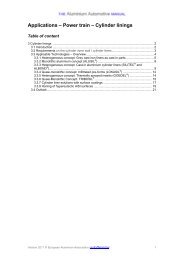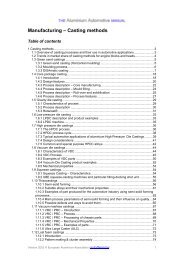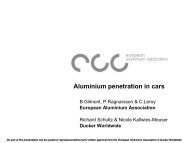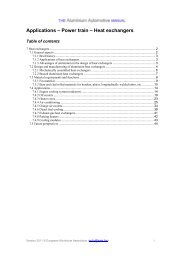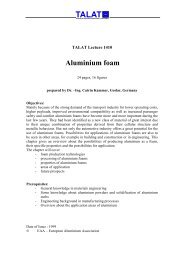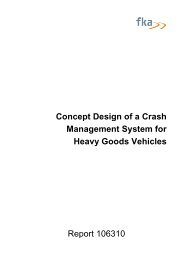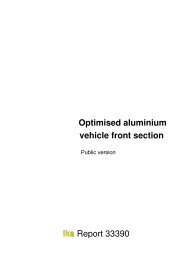aluminium in commercial vehicles - European Aluminium Association
aluminium in commercial vehicles - European Aluminium Association
aluminium in commercial vehicles - European Aluminium Association
You also want an ePaper? Increase the reach of your titles
YUMPU automatically turns print PDFs into web optimized ePapers that Google loves.
EUROPEAN ALUMINIUM ASSOCIATION ALUMINIUM IN COMMERCIAL VEHICLES CHAPTER VIII 113<br />
3.2. Automatic MIG<br />
weld<strong>in</strong>g<br />
Here, the weld<strong>in</strong>g torch is automatically<br />
guided.<br />
This is normally used for very<br />
long straight welds where an<br />
automatic system is profitable. A<br />
good example is fabrication of<br />
chassis side members consist<strong>in</strong>g<br />
of two “T” sections welded to<br />
either edge of a central plate<br />
which forms the web of the<br />
built-up beam. The two welds<br />
would normally be made automatically<br />
and at the same time to<br />
avoid problems of deformation.<br />
Automatic weld<strong>in</strong>g is also preferred<br />
where an attractive<br />
appearance is desirable, e.g. for<br />
stiffen<strong>in</strong>g channel welded to the<br />
side panels of vehicle bodies.<br />
Here the appearance and size of<br />
the weld bead can be repeated<br />
to achieve the impression of consistency.<br />
F<strong>in</strong>ally, automatic weld<strong>in</strong>g - both<br />
TIG and MIG - provides a repeatable<br />
weld<strong>in</strong>g quality provided of<br />
course that the weld<strong>in</strong>g parameters<br />
are fully def<strong>in</strong>ed to beg<strong>in</strong><br />
with.<br />
Weld<strong>in</strong>g of side panels<br />
for tippers (Menci)<br />
3.3. Smooth current MIG<br />
Weld<strong>in</strong>g<br />
This fast and economical process<br />
allows deposit<strong>in</strong>g a great quantity<br />
of filler metal per unit of time.<br />
The energy <strong>in</strong>put is such that<br />
butt welds can only be produced<br />
with the use of a back<strong>in</strong>g bar,<br />
either <strong>in</strong>tegrated <strong>in</strong>to the shape<br />
of the extrusion or as temporary<br />
removable feature <strong>in</strong> sta<strong>in</strong>less<br />
steel, copper or even <strong>alum<strong>in</strong>ium</strong>.<br />
Due to the relatively high weld<strong>in</strong>g<br />
speed, the heat affected<br />
zone1 is narrower than with TIG<br />
weld<strong>in</strong>g and thus the distortion<br />
of the assemblies is less.<br />
1. The extent of the heat affected zone<br />
and the strength <strong>in</strong> the heat affected<br />
zone are given <strong>in</strong> EN 1999-1-1.<br />
Th<strong>in</strong> gauge material below 3 mm<br />
is difficult to weld with this<br />
process because of the high<br />
energy of the arc. If no other<br />
equipment is available, then a<br />
th<strong>in</strong> gauge filler wire may be<br />
used with reduced energy <strong>in</strong>put,<br />
but then the wire feed can cause<br />
<strong>in</strong>stability of the process even if a<br />
push-pull equipment is used.<br />
If the preassembly of structures is<br />
carried out with stitches <strong>in</strong> the<br />
MIG process, these short runs<br />
must have a similar cross section<br />
as the first weld pass and be<br />
some 100 mm long to be sound.<br />
Before production weld<strong>in</strong>g, these<br />
stitches must be reduced <strong>in</strong> cross<br />
section by mechanical means (no<br />
disc gr<strong>in</strong>ders), so that they can<br />
be molten up with the weld pass<br />
and do not leave imperfections<br />
near the root.



